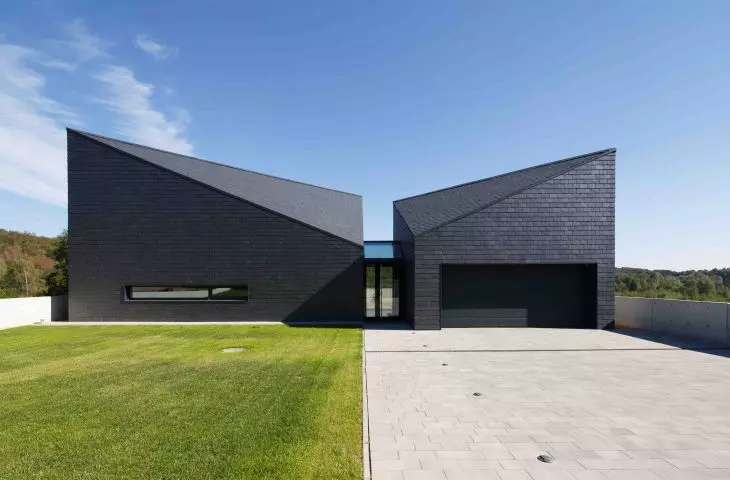The current geopolitical situation has entailed significant increases in commodity and energy prices. The prices of gas, electricity, coal and biofuels have risen compared to previous years, which has directly translated into increased building maintenance costs.
It is obvious that we are looking for solutions to save money and reduce energy demand. There are several ways to do this. The first would be to look at heat loss. Leaky windows, poor insulation of the building envelope and roof. Next, you can consider upgrading the building's heating and ventilation system. If we see the need for changes, it is worthwhile - in the case of thermal modernization of the building - to choose a ventilated facade with natural slate cladding.
Ventilated facades made of slate - a durable and economical solution
© Slate.pl
A ventilated façade made of slate is a solution for every budget. At the investment stage, the cost of such a solution is higher compared to other materials, but in the long run it brings many benefits. The high durability and strength of the material slate provides the investor with peace of mind for many years in the context of the absence of maintenance costs, repairs, painting, etc. It should also be emphasized that slate is a natural product, it does not negatively affect the environment and surroundings. On the contrary, it blends harmoniously with other natural materials and the surrounding nature of the building. The unique structure of slate and the play of shades of anthracite color with a sunny facade is an effect that is difficult to achieve using other materials. Slate is a natural product.
Ventilated facades made of slate - a durable and economical solution
© Slate.pl
From the technical and execution side, slate can be installed in several ways. The first, the most popular and used for centuries, is mechanical installation with nails or screws to a wooden substrate. The ways of laying are many. Slate tiles can be of various sizes and shapes, and are about 5 mm thick. The stone is laid with the correct top and side overlap. Proper overlap ensures the tightness of the facade. For partitions with increased fire protection requirements, we can replace the wooden substrate with, for example, a splinter-cement board. The second way of installation is based on slate with a thickness of 1 cm and more. In this case, we use a different construction layout. The slates are not mechanically mounted, but hung on system clips or safety pins in an invisible mounting arrangement. For more information, visit www.lupek.pl
Ventilated facades made of slate - a durable and economical solution
© Slate.pl
The layout of the partition layers depends on the needs of the investor. For single-family houses, the most common choice is a wooden structure and mineral wool as an insulator. The wool can be laid in a cross or single structure arrangement. The manufacturer recommends the use of C24 KVH dry structural wood, both as a support structure and as a substrate for the slate, i.e. dry boards or battens. For a system with higher fire protection requirements, the wood should be replaced with aluminum and a board with the appropriate fire rating, to which the slate is bolted. An alternative to the board is a flat aluminum sheet with a minimum thickness of 1 mm.
Ventilated facades made of slate - a durable and economical solution
© Slate.pl
Architecturally, slate blends perfectly with wood, glass and concrete, materials that architects and investors often turn to. For houses built in a modern style, double rectangular roofing is often chosen. Undoubtedly, the advantage of this solution is that the same material can be used and laid on the roof and facade. Going a step further, there is nothing to prevent a fragment of such a facade from being laid inside the building.
Ventilated facades made of slate - a durable and economical solution
© Slate.pl
When consciously choosing slate, it is important to remember that as a natural product it is unique also in terms of structure. Slate tiles even from a single deposit differ subtly in appearance. We can't speak of a uniform color here. The slate looks different in full sunlight, different in the shade, wet or dry. Therefore, we can say that it is a perfectly imperfect material.
Another argument for the use of slate is that its use increases the value of the property. Exclusive and quality materials defend themselves when the property is sold.
Ventilated facades made of slate - a durable and economical solution
© Slate.pl
In conclusion, it is worth emphasizing the versatility of the use of this material in construction. The history of the use and extraction of this material dates back to the Roman Empire and the first centuries of our era. The first residential buildings were covered with irregular sheets of slate chipped from the ground. Further development of mining and craftsmanship up to the present has enabled us to have free access to this raw material, technical knowledge of the possible applications and optimization of production to obtain a product that is durable and economical.
Ventilated facades made of slate - a durable and economical solution
© Slate.pl













































